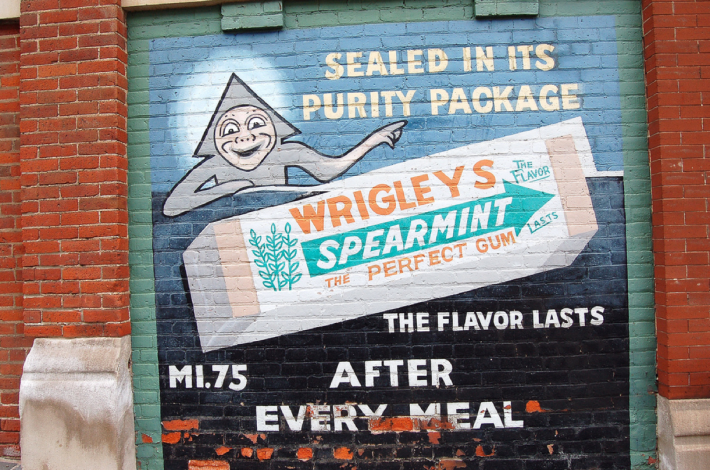The Wrigley Company, founded on April 1, 1891, was started by William Wrigley, Jr. when he arrived in Chicago from Philadelphia to carry on his father’s soap business. An excellent salesman, Wrigley provided a thank-you to merchants for carrying his soap product, as well as an incentive for them to continue to do so, in the form of free gifts: watches, umbrellas, spoons, small lamps. Wrigley was always trying to stay at the top of his salesman game. At one point he completely traded his products (soap and umbrellas) for another salesman’s product (baking powder) in the hopes of having more success with a different product. He eventually came upon the idea of using chewing gum as his incentive product, using the Zeno Manufacturing Company as his provider.
“By 1893, Zeno was producing dozens of chewing gum brands custom ordered by Wrigley. Early flavors included Vassar, Sweet Sixteen, Peppermint, Lemon Cream, and Blood Orange. In addition to these obscure flavors were two that what would become enduring Wrigley products—Juicy Fruit and Spearmint gums. Juicy Fruit was introduced to a nation-wide audience at the World’s Columbian Exposition.”
His chewing gum soon became one of the most sought after products. In 1907, William Wrigley initiated an advertising campaign that set the standards for many companies to follow. The campaign featured Spearmint gum on billboards, cars, and newspapers, with the familiar slogan, “The Flavor Lasts.” 
Wrigley promoted the importance of chewing gum to all ages, encouraging customers to chew in-between meals and after “smokes,” as well as altering Mother Goose Rhymes to catch kids’ eyes. Wrigley was also one of the first to create an “ad creature” to promote a company product. They used the “Spearman.”
William Wrigley not only the inventor of chewing gum, but his advertising proficiency made Wrigley’s Spearmint Gum the most popular chewing gum in the world by the year 1910. Once World War I began, Wrigley set the soldiers out with packs of gum to further promote his product. Later, he involved himself in politics, recreational activities, and sports, including baseball, which led to him to becoming majority stockholder of the Chicago Cubs in 1916. What followed was the naming of the Cub’s ballpark as Wrigley Field, and the surrounding neighborhood as “Wrigleyville.”
In 1924, the company moved into its current headquarters on Michigan Avenue, the Chicago landmark Wrigley Building. Wrigley no longer has any manufacturing plants in Chicago, the last one on Ashland St. having closed in 2006. Their corporate headquarters and sales company are still in Chicago, as is the Wrigley Global Innovation Center (GIC). Wrigley is now a subsidiary of Mars, Inc.

